About Speech and Language Disorders
A helpful guide for parents with kids with speech disorders
Any disruption in the process of communication can affect an individual's ability to communicate and interact with family, friends, peers, teachers and/or employers. A speech and language disorder can impact academic progress including, reading and writing. Effective communication is the essence of interaction and necessary across all settings. The following information may help you understand and recognize the signs of communication disorders so that you can seek the help that you need from a licensed Speech-Language Pathologist.

Common Speech Disorders
Articulation and Phonology
Difficulty with speech sound production beyond developmentally appropriate ages. A child may omit, distort, substitute or add sounds making speech difficult to understand.
Apraxia
A motor programming speech disorder that affects an individual's ability to sequence and say sounds in syllables and words. Individuals know what they want to say, but their brains have difficulty coordinating and programming the muscle movements necessary to execute the words.
Dysarthria
A motor speech disorder characterized by a “slurred” sound. A person with dysarthria may also demonstrate difficulty with pitch, loudness and rhythm of speech, as well as saliva control.
Language Delays / Disorders
Expressive Language
An individual’s ability to use language. A child may demonstrate difficulty expressing thoughts and ideas, retelling stories, responding appropriately and/or using appropriate sentence structures. Reading and expressive writing may also be affected.
Receptive Language
An individual’s ability to understand language concepts and follow directions. An older child may demonstrate difficulty interpreting figurative language and words with multiple meanings. Reading, writing and spelling may also be affected.
Aphasia
A disorder that results from damage to the language centers in the brain. Characteristics may include word finding problems, difficulty expressing thoughts, difficulty following directions and answering questions, as well as participating in conversations. It may also affect reading and writing.
•
Social-Pragmatic Deficits
Difficulty using socially appropriate language. Pragmatic language impairments affect an individual's ability to interpret and use para-linguistic (non-verbal) cues while interacting with others. An individual with this type of deficit may demonstrate difficulty with the use of body language and eye contact, entering and exiting conversations and understanding how to make and maintain friendships. These deficits are typically seen in children, adolescents and adults on the autism spectrum.
Voice Disorder
Difficulty producing and using an appropriate voice for age and gender. Voice disorders result from abuse, misuse and/or physical anomalies. An individual may demonstrate difficulty with pitch, loudness or quality (breathy, hoarse, etc..).
Auditory Processing Disorder
A deficit in processing information that is specific to the auditory modality. Deficits in auditory processing may affect a person's ability to distinguish, recognize and/or integrate auditory information. Comprehending and processing speech may be difficult despite normal hearing. Individual's with APD often exhibit poor listening skills, academic difficulty, reading and spelling difficulty, problems with attention and other auditory related difficulties.
Stuttering/Fluency Disorder
A communication disorder that interrupts the flow or rhythm of speech. Stuttered speech often includes repetitions of words, parts of words or prolongations of speech sounds. At times, the flow of speech may become completely stopped or blocked.
What is Occupational Therapy?
 Occupational therapists complete evaluations and assessments, and work with other members of the IEP team to determine a student’s needs and receive a free, appropriate public education (FAPE) in the least restrictive environment. They collaborate with the team to identify a student’s goals and identify the services, supports, modifications, and accommodations required for the student to achieve them. Educationally related OT services are provided within the context of the child's educational program. The goal of intervention is to assist the child to function in the school setting by adapting the environment, revising the functional tasks, and by promoting elements of sensory and motor development.
Occupational therapists complete evaluations and assessments, and work with other members of the IEP team to determine a student’s needs and receive a free, appropriate public education (FAPE) in the least restrictive environment. They collaborate with the team to identify a student’s goals and identify the services, supports, modifications, and accommodations required for the student to achieve them. Educationally related OT services are provided within the context of the child's educational program. The goal of intervention is to assist the child to function in the school setting by adapting the environment, revising the functional tasks, and by promoting elements of sensory and motor development.
